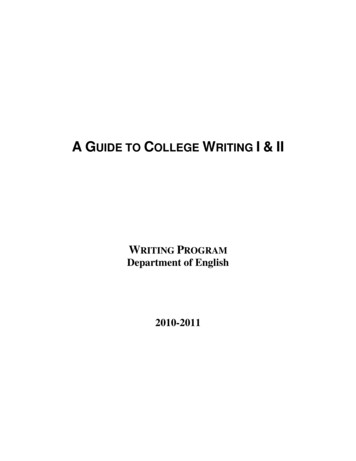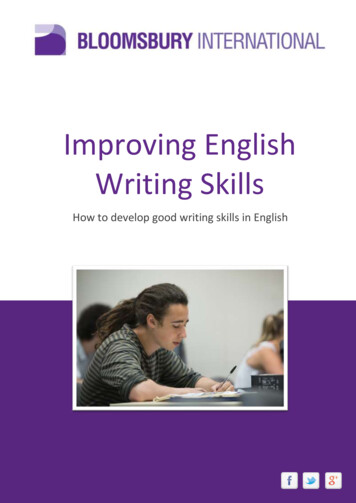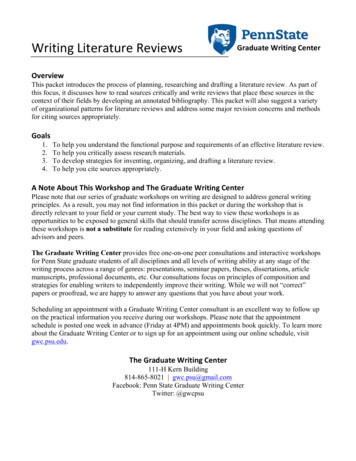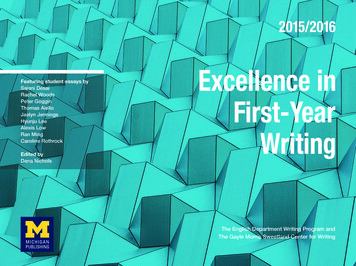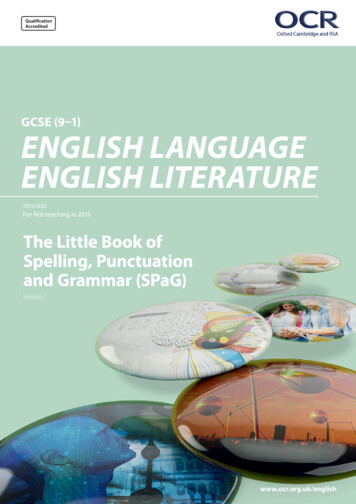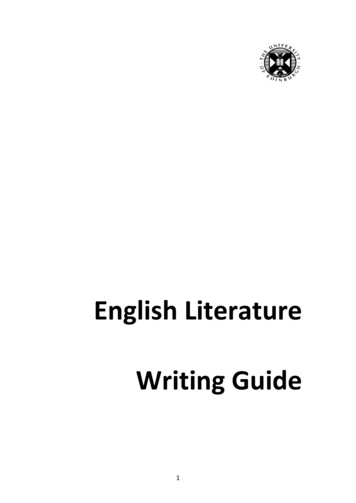
Transcription
English LiteratureWriting Guide1
Contents:Guidelines for Essay Writing3Writing Examinations9Stylesheet11Plagiarism17Grade Descriptors182
GUIDELINES FOR ESSAY WRITINGThese guidelines provide help with essay writing. Students might also find ithelpful to consult the following (available in the University Library):Nigel Fabb and Alan Durant. How to write Essays, Dissertations and Theses inLiterary Studies . London: Longman, 1993.INTRODUCTIONWhile most of you have already had experience of essay writing, it is important torealise that essay writing at University level may be different from the practices youhave so far encountered. The aim of this tutorial is to discuss what is required of anEnglish Literature essay at University level, including:1. information on the criteria in relation to which your essay will be judged2. how to plan and organise an essayo Planning an Essayo Essay Structureo Independence and Critical Readingo Use of Secondary Material3. advice on writing style4. a final checklist5.WHAT ARE THE CRITERIA?In assessing essays, your tutors are asked to bear in mind: Relevance to the essay-subject as it has been set;A well-defined line of argument, with each stage clearly marked;Appropriate, economical, and accurate illustration;Mastery of the relevant background material (contextual, critical,theoretical), and evidence of independent and wide-ranging reading;Evidence of independent thinking about the subject, and, where ideas aretaken from critics, ability to apply them to materials of the student's ownchoice;Crisp expression. Failure to stay within the maximum number of words set forwritten work will be penalised;Spelling, punctuation, grammar;Accurate and comprehensive referencing of sources and list of Works Cited.See also the Grade Descriptors for the English Literature department below.3
HOW TO PLAN AND ORGANISE AN ESSAYPlanning an EssayCareful planning is the key to producing a good essay. Do NOT begin to write youressay the night before it is due to be submitted. You should allow yourselves time toconsider, plan, write, rewrite and revise, and proof read your essay before itssubmission. The diagram and questions reproduced below will assist you in planningyour essay.4
ESSAY STRUCTUREYour essay should present a discussion and a reasoned argument: it should not be aset of random reflections on the texts or topic you have chosen. This will requiresome planning and organisation of your material before you begin to write, toensure that your argument is coherent and engages directly with the question asked.A good introduction is often the key to a good essay. The first thing you should do isdefine any complex or potentially ambiguous terms in the question. This can also beone good way of effecting an introduction. Another is to consider why the questionmight be asked, what makes it interesting, or why it is relevant to the texts you areconsidering. You might also use your introduction to outline briefly your intentions inwriting the essay: but remember that for a 1,000 or 2,000 word essay theintroduction will necessarily be brief.5
The body of the essay of the essay should relate to the issues you outline in yourintroduction. It also needs a coherent structure: if you have used your introductionto identify the key issues of your discussion, structuring the essay becomes easier, asyou can address these issues in separate paragraphs. Make the links and transitionsbetween paragraphs clear. Remember that every paragraph and sentence shouldcontribute directly to your argument.Your essay needs to strike a balance between argument and supporting evidence.Avoid unsupported generalisations. Stating that 'society is a patriarchy' or that 'evil ismore interesting than good' without offering evidence to support the assertion islittle different from claiming that 'the earth is flat' or 'tall people are more intelligentthan short ones'. Even your more particular points about texts or issues always needsupporting evidence, often in the form of quotations from the texts. Remember thatyou may need to explain how your evidence supports your point.Your essay needs a conclusion to avoid it petering out and losing its force. You mightuse the conclusion to draw together the threads of your argument, to re-visit theoriginal question, or even to point towards new questions that your discussion hasopened up. Whatever your conclusion, you should use it to step back slightly fromthe detail of the preceding argument to re-consider the wider picture.INDEPENDENCE AND CRITICAL READINGThe purpose of an essay is to develop and present your own thinking about the textsand issues raised by the question. All essays are likely to draw on ideas taken fromothers, whether from critical books, lectures or discussions. But clearly an essay isnot intended to be simply an anthology of others' ideas: those ideas should only beintroduced in order to form and advance your own argument, which is both thesubstance and the purpose of the essay.USE OF SECONDARY (CRITICAL) MATERIALCritical books and articles are often useful in stimulating your ideas about theliterature you are writing on. It is also important to develop some awareness of theongoing critical debate about works and literary issues; sometimes you may even beasked to write about the critical or theoretical works themselves. But ideas andwords from other writers should never simply replace your own, either directly, or inthe form of paraphrase. Quoted or paraphrased thoughts and words from anothercritic should be included in the text of your essay only if you wish to say somethingabout them. You may want to take issue with them, or to develop them, or toillustrate a particular view which you then discuss. It is not helpful to quote from orparaphrase critics simply because you think their words sound more authoritativethan your own.While you will often draw on other critics' ideas, you need to distinguish their wordsand opinions clearly from your own. Students should exercise caution and care in theuse of paraphrase in particular. It is imperative that the reader should always be able6
to distinguish your voice and argument from that of the critics you cite. So avoidsimply ventriloquising critical arguments and conduct instead a critical engagementwith them. For example, do not accept interpretations in critical works as matters offact; demonstrate to the reader of your essay the ways in which you have produceda thoughtful response to the critics that you have employed.If you do not ensure that there is no confusion in an essay about the origin of itsarguments, you will find that your readers are unable to judge your arguments. Youwill also lay yourself open to a charge of plagiarism, which is a serious academicoffence. (See the section on Plagiarism below).Make sure your essay obeys these rules: Words drawn directly from another writer should always be put in quotationmarks: it is not acceptable to offer them incorporated into the body of youressay as if they are your own, even with minor variations. If you either paraphrase a critic or other source, give a brief citation withinbrackets at that point (but see the cautionary note re paraphrasing above).STYLEUniversity level essays should be written in a formal style and demonstrate yourunderstanding of the codes of academic discourse as they relate to the study ofEnglish Literature. While there are variations between different disciplines, thereare three main characteristics that are common to all academic essays. These are: An overriding concern to interpret and make meaning through thepresentation of arguments; Careful attention to the marshalling of relevant and valid facts, examples andother kinds of evidence to substantiate or refute arguments andinterpretations; A structure or organisational framework which has not been chosenarbitrarily, but is instead designed to present arguments and evidence in acoherent and logically appropriate form.Clarity and expressiveness of language is obviously particularly important in essayson literature, and the development of an accurate and engaging writing style is oneof the aims of a degree in this discipline.7
FINAL CHECKLIST Have I completed the cover sheet correctly? Does my introduction: Set the question/topic against a wider background? Clarify my understanding of the question/topic? Define key or problematic terms? Outline the approach I will be taking? Does the main body of the essay: Present my key points clearly? Develop an argument in a logical sequence? Systematically support key points and argument with evidence /examples? Accurately cite all sources used, even if not quoted directly? Does my conclusion: Bring together the main points? Link back to the question/topic? State clearly the conlusion(s) of my argument? Does my essay: Read clearly throughout? Make correct use of grammar, syntax and punctuation? Include a list of all cited sources? Conform to the word limit set for this assignment?8
WRITING EXAMINATIONSExaminations can be daunting, but they remain a valuable test of the critical skillsyou have acquired and of your ability to deploy them. The following paragraphswill help you to understand what is being asked of you in an examination.It is the purpose of exams to enable students to demonstrate width and depth ofreading and the ability to develop an argument and support it with illustration. (Itis not the purpose of exams to encourage the student merely to write out his or herclass essays for a second time, or simply to transcribe notes taken in lectures thathave a vague connection with the question set.) You will be expected to show yourbreadth of reading, and the rubrics on the papers will warn you about repetition ofmaterial. Obeying the rubrics is an important part of examination technique;disobeying them leads to major deduction of marks.In writing examination answers, as much as in writing essays, you are seeking toformulate a clear and well-argued response to the question that has been asked. Ofcourse you will not be expected to write in the same detail and depth as in your termessays. It is no good simply laying out all you know about a particular text/author forthe examiner's admiration. Take time at the beginning of the exam to choose thequestions you wish to answer, making sure that you follow any rubric with care (e.g.one question from Section A, one from Section B, and a third from either); if youviolate a rubric, your paper will be penalised (normally this means that the answer inwhich the rubric is broken has its mark halved).It is a good idea to write out the question at the beginning of your answer as well asnumbering it. You should draw up a rough plan but remember to cross it out. Engagedirectly with the question asked. As with any other essay, you should have anintroduction, an argument and a conclusion; the essay should offer a discussionwhich engages with more than a single point of view on the issues involved. Part ofthe skill of producing good examination answers is to know what to leave out as wellas what to put in. If you have quotations that you want to use, make sure that theyare fully illustrative of the point you are making and not just dragged in because youknow them. If your answer consists of analysis as well as description, is clearlyargued (and written), exhibiting thoughtfulness about the question asked (andperhaps some breadth of knowledge of the course as a whole), it is likely to get agood mark. If you simply describe the contents of whatever text/s you arediscussing, with no evidence of analytic skills and/or any attention to the question, itwill not do so well. Make sure you are answering the question asked: unthinkingrepetition or paraphrase of lecture material or course essays is unlikely to fulfil thatrequirement.Misspelling and/or mispunctuations (e.g. failure to use apostrophes properly; usingcommas where full stops are needed) give a very bad impression and will also affectyour mark.9
Always divide your time carefully. One very good, very long answer can neverachieve a mark high enough to compensate for a second incomplete, overly short orabbreviated answer.Take your time, think, and write clearly. With preparation and thought, exams canbe intellectually stimulating rather than an ordeal. They are there to assess yourcapacity to respond quickly, to write intelligently and clearly in relation to particularquestions, and to show your capacity for stimulating and thoughtful writtendiscussion under time pressure. As such they are a valuable part of the transferableskills you are developing at University.10
STYLE SHEETThere are many different presentational styles around. The Department of EnglishLiterature prefers the style approved by the Modern Language Association, knownsimply as ‘MLA Style’. All written work submitted to the Department shouldconform to the following guidelines.I. PRESENTATION AND LAYOUTEssays should be typed or word-processed, double-spaced.Pages should be numbered consecutively in Arabic numerals, including the final pagewhich comprises the list of Works Cited. The page number should appear on the topright-hand corner of each page.The beginnings of paragraphs should be indented five spaces from the left-handmargin. No additional space should be inserted between paragraphs.Use a clean font in a size that is clearly legible. Times New Roman (12 point) is ideal.As well as the use of grammatical sentences, it is important to use paragraphsintelligently. Each paragraph should represent a coherent element within adeveloping argument.II. TITLESIdeally, ITALICISE (or if necessary underline) the titles of: books, plays; long poemspublished as books; pamphlets; and periodicals (newspapers, magazines andjournals).Examples: Oranges Are Not the Only Fruit; Henry IV, Part 1; Paradise Lost; TheScotsman; Studies in Scottish Literature.ENCLOSE WITHIN SINGLE QUOTATION MARKS, and do not underline, the titles ofarticles; essays; short stories; short poems; songs; chapters of books; unpublishedworks (such as lectures, speeches and dissertations).Examples: ‘The Traffic in Women: Notes on the “Political Economy” of Sex’;‘Tradition and the Individual Talent’; ‘The Library Window’; ‘To His CoyMistress’; ‘The Flower of Scotland’; ‘Judges’ (in Oranges Are Not the OnlyFruit).This distinction is made in order to avoid ambiguity or confusion: ‘King Lear isconfused’ is a comment on the character of that name; ‘King Lear is confused’ is ajudgment on the play. ‘"High Windows" is Philip Larkin's finest achievement’ refers11
to a single poem; ‘High Windows is Philip Larkin's finest achievement’ refers to acomplete collection.III. PUNCTUATIONThe sense of your essay depends on its punctuation as well as on the words youchoose. These are some common problem areas:a. Capitalization. In titles capitalize the first letter of the first word and of all theprincipal words including nouns and proper adjectives.Examples: To the Lighthouse, A Portrait of the Artist as a Young Man, APassage to India, Sons and Lovers, The Novel: Modern Essays in Criticism).Capitalize references to parts of a specific work.Examples: Mahood's Introduction (in Twelfth Night), Morrell’s Preface (inFour English Comedies).b. Exclamation marks should be sparingly used.c. Italics. As well as italicising (or if necessary underlining) the titles of publishedbooks, plays, pamphlets, periodicals, and long poems, also italicise foreign wordsused in an English text (except quotations, titles of articles, proper names andforeign words anglicized through usage).The underlining or italicising of words, phrases or sentences for emphasis should bedone sparingly.d. Quotation marks. Be consistent in your punctuation. If you use single quotationmarks, use them in the same circumstances throughout. The British system usessingle quotation marks first, double quotation marks for quotations withinquotations.Example: According to Northrop Frye, ‘The word “grace” with all itsRenaissance overtones from the graceful courtier of Castiglione to thegracious God of Christianity, is a most important thematic word inShakespearean comedy.’e. Rhetorical questions, i.e., questions asked for effect rather than genuine enquiry,should be sparingly asked in your essay.f. Square brackets. Use them for a parenthesis within a parenthesis, to encloseinterpolations in a quotation, or to complete missing information.Example: F.P. Wilson suggests that ‘in Marlowe’s share of the play [DoctorFaustus] there is nothing of predestination and reprobation’.12
g. Colons and Semicolons. These are often under-used: use them sensibly. Inparticular, where part of a sentence could stand on its own as a separate sense-unitor sentence (as in the last sentence) it should be preceded by a colon or semi-colonand not just a comma.IV. NAMES OF PERSONSPoets, playwrights, novelists are customarily referred to by their surnames, e.g.,Shakespeare, Marlowe, Goldsmith, Woolf. In essays, one refers simply to Byron(rather than Lord Byron) or Tennyson (rather than Alfred Lord Tennyson) or Woolf(rather than Virginia Woolf). Exceptions would include Eliot (which might refer to T.S.or George) or James (where it might refer to Henry or William). Well knownauthorities cited in your text (e.g., Barthes, Foucault, Freud, Marx) may be referredto similarly. When less well known literary critics are first mentioned in your essaythe full name should be given; on subsequent occasions in the same essay thesurname only is used.V. NUMERALSIn general, numbers of fewer than three digits should be spelled out in words.However, if Arabic numerals are used for numbers over 99, use them also for smallernumbers in the same sentence or related groups of sentences.Dates. Be consistent in your style: either '17 August 1991' or 'August 17, 1991,' butnot both. Correspondingly, use either 'August 1991' or 'August, 1991,' but not both;'in 1981-82' or 'from 1981 to 1982'; '500 B.C.' but 'A.D. 500'. In your text, spell outreferences to centuries, e.g., 'the nineteenth and twentieth centuries'.VI. QUOTATIONSa. Quote accurately. If you underline words for emphasis, you should indicate thatthe emphasis is yours. Use ‘sic’ sparingly [within square brackets] to show that theerror appears in the original and is not yours.Example: The Home Herald printed the mayor’s letter, which was an appealto his ‘dear fiends [sic] and fellow citizens’.b. Ellipsis. For ellipsis within a sentence, use three . . . spaced periods, leaving aspace before the first period. Quotations that are complete sentences should endwith periods even though matter in the original may have been omitted. To indicateellipsis after the conclusion of a complete sentence, use four periods with no spacebefore the first. . . .c. Integrated quotations. Verse quotations of part of a line or a single line arenormally run-on, i.e., integrated in your text and placed within quotation marks.Lines of verse are separated by a slash (/).13
Example: Cummings admires his father for moving ‘through dooms of love /through sames of am through haves of give’, for his resilience andgraciousness of spirit in confronting the vicissitudes of life.Prose quotations of fewer than four lines should be run-on as part of your text,placed within quotation marks, and the sentence which includes the quotationshould make grammatical sense.d. Long quotations. When a quotation extends for more than four typed lines ofprose or three lines of poetry, it should be introduced by a colon (unless it is run-on)and set off from the text by indenting the entire quotation ten spaces from the leftmargin. It should be double spaced and there should be no additional space above orbelow. No quotation marks are required when it has been set off from the text inthis way. It should not be italicised and should not be centre-justified.VII. REFERENCES IN THE TEXTProper referencing is a key part of any essay, allowing your reader (and you, infuture) to check or work further with the sources you have used. Accurate and fullacknowledgement of these sources also ensures that you avoid any risk of plagiarism– by showing clearly and exactly how and from whom you have derived any ideas orexpressions not originally your own.While footnotes and endnotes were once the convention, they have now beenreplaced by brief citations within the text. Your reader should be able to find the fullcitation for all of your references in your Works Cited List which should appear at theend of your essay.In-text references should appear in brackets within your main text. Where theidentity of the source is apparent from the context, only a page number is required.Where the source is not apparent, you should provide the author’s name and thepage number.Examples: According to Fussell, ‘the Oxford Book of English Verse presidesover the Great War in a way that has never been fully appreciated’ (159).As one critic has asserted, ‘the Oxford Book of English Verse presides over theGreat War in a way that has never been fully appreciated’ (Fussell 159).The Oxford Book of English Verse played a defining role in the culture of theFirst World War (Fussell 159).Where more than one work by the same author is being cited, then the short title ofthe relevant work should be included:Example: (Fussell, Great War 159).14
Content footnotes, on the other hand, may be included but should be kept to aminimum. They should be consecutively numbered (in superscript), single spaced,and appear at the bottom of the page.Example: Where the main text reads:It has been asserted that the Oxford Book of English Verse played a definingrole in the culture of the First World War (Fussell 159).1The content note might read:1While Fussell’s emphasis on polite reading practices held sway untilrelatively recently, historical accounts have since emerged which emphasisethe importance of popular working class culture in the British trenches.For further advice on the use of in-text references you should consulthttp://www.dianahacker.com/resdoc/p04 c08 s1.htmlVIII. WORKS CITEDA list of all works cited should appear on a new page at the end of your essay,arranged in alphabetical order. Use quotation marks (but not italics or underlining)for titles of articles, essays, short stories, short poems, songs, chapters and sectionsof books. Use italics or underlining for titles of published books, plays, long poems,pamphlets, periodicals, operas, films and classical works.Please note: the following are just a few examples of the different kinds of entriesthat you might have to use. If you can’t find what you are looking for here, youshould consult http://www.dianahacker.com/resdoc/p04 c08 s2.html.1. A book with a single author: the simplest form of reference.Fussell, Paul. The Great War and Modern Memory. Oxford: Oxford University Press,1975.2. Two or more books by a single authorFussell, Paul. The Great War and Modern Memory. Oxford: Oxford University Press,1975.---. Wartime: Understanding and Behaviour in the Second World War.Oxford: Oxford University Press, 1989.3. A book by multiple authorsHughes, Linda, and Michael Lund. The Victorian Serial. Charlottesville: UniversityPress of Virginia, 1991.4. An edited collection of essaysWatt, Ian, ed. Pride and Prejudice: A Collection of Critical Essays. Englewood Cliffs,NJ: Prentice Hall, 1963.5. A work in a collection15
Brower, Reuben A. ‘Light and Bright and Sparkling: Irony and Fiction in Pride andPrejudice. ’Jane Austen: A Collection of Critical Essays. Ed. Ian Watt. Englewood Cliffs , N.J.:Prentice Hall, 1963: 62-75.6. An editionShakespeare, William. Anthony and Cleopatra. Ed. John Dover Wilson. Cambridge:Cambridge University Press, 1968.---. Twelfth Night. Ed. J. M. Lothian. London: Methuen, 1975.7. An article in a journalReiss, Edmund. ‘Medieval Irony.’ Journal of the History of Ideas 42.2 (1981): 209-26.8. A web siteThe quality of web site content varies enormously, from refereed journals byreputable academic presses to discussion groups for teenage fans of WutheringHeights. You should therefore be particularly cautious about the electronic sourcesthat you use. As with printed sources, there is a prescribed format for the citation ofelectronic texts. Entries should include (where applicable) the name of the author,title of the web page, title of the site, date of publication, date it was accessed, andurl:Jones, Mary. ‘Why read Wordsworth?’ Life and Work of Wordsworth. 2002. 15 Nov.2004 http://www.englishistory.net/wordsworth.html .Detailed guidance regarding the documentation of web sites, in their variousmanifestations, can be found athttp://www.dianahacker.com/resdoc/p04 c08 s2.html.16
PLAGIARISMPlagiarism is the use of material taken from another writer's work without properacknowledgement, presenting it as if it were your own. While it is perfectly proper inacademic study to make use of another person's ideas, to do so under the pretencethat they are your own is deceitful. Plagiarism, whether in coursework orexaminations, is always taken extremely seriously within the university as it is a formof cheating. Work found to be plagiarised may be penalised, assessed at zero, or notaccepted, and in serious cases may lead to disciplinary action being initiated.Work undertaken for our courses is designed to help you develop your knowledgeand understanding, and your own powers of analysis and argument. Essays, examsand exam essays assess these skills. Plagiarism therefore undermines the wholepurpose of the academic study of literature. For all work for the department’scourses, it is important to be aware of, and to acknowledge the sources ofarguments and words. This applies to material drawn from critical books andlectures, but also from the work of other students (including tutorial or seminardiscussions) and from the internet and other electronic sources. Lectures, tutorialsand seminars must not be recorded or otherwise transmitted, unless there is specialdispensation relating to disability (endorsed by the Disability Office). Tutors willcheck web-based material, as well as other sources, where they have reason tosuspect that the writing a student submits does not represent their own ideas, wordsand arguments.While deliberate plagiarism involves an intention to deceive and is easy to avoid, it ispossible to fall unawares into practices which could be mistaken for plagiarism if youare not familiar with the proper means of using and acknowledging material fromother writers. Inadequate referencing and inappropriate use of others' materialcould inadvertently lay you open to charges of plagiarism. Since different subjectsinvolve different uses of material, and may have different conventions about how itshould be acknowledged, it is important that in each of their subjects studentsconsult departmental guidelines about the purpose and presentation of writtenwork in that discipline.17
GRADE DESCRIPTORSAll written work you submit is marked in relation to the grade descriptors set out below.The numerical mark you receive should be understood in relation to these descriptors,which itemise for you not only the different aspects of your performance that are beingassessed but also what you need to achieve in order to attain a particular class of mark.We assess what you achieve in your written work with reference to four broad areas:Knowledge, Argument and Analysis, Language and Expression, and ScholarlyApparatus.Knowledge covers the extent and depth of your knowledge and understanding of theprimary texts, your grasp of the conceptual, formal and historical issues and frameworksrelevant to their analysis in this context, and your understanding of the scholarly andcritical debates and analyses that bear upon the texts and topic.Argument and Analysis addresses what you manage to do with the knowledge you’veaccumulated – how far you construct a logically clear and coherent argument inresponse to the question posed, how alert that argument is to textual and conceptualnuance, how wide-ranging your claim, and how aware you are of possible counterarguments that you might need to address. In addition, we’re assessing whether you’vebeen able to support your argument convincingly and thoroughly in referring to theprimary texts under discussion, so that there’s sufficient evidence cited, and it issufficiently telling, to ensure that your argument gains purchase on those texts. Finally,we’re looking here to assess how far you’ve managed to make your argument your own,or whether it is too substantially dependent either on lectures, tutorial and seminardiscussions, or your reading in the secondary material.Language and Expression focuses on how you say what you say – whether your spellingis good and you write in a grammatically correct fashion, certainly, but also the extent towhich your writing is clear and your vocabulary and tone appropriate to the task. We’realso looking here to see how far your sentence and paragraph structure help to supportand convey the argument you’re looking to make.Scholarly Apparatus – have you provided references for all cited work, and is itcompletely and properly clear when you are speaking in your own words, and when youare paraphrasing or borrowing another’s? Is the risk of plagiarism successfully avoided?Are your references in the appropriate format? Is your Works Cited list consistent withthe references in your text?These four components are all important, and all related to each other, so we cannotgive a fixed and single figure for the proportion of marks available for each one.However, it is fair to say that Knowledge and Argument and Analysis are clearlyfundamental, and the balance of strengths and weaknesses in these areas will have a bigimpact on your overall mark. Some weaknesses in Language and Expression have amore serious impact than others: poor spelling is a problem, and needs to be addressed18 page
English Literature essay at University level, including: 1. information on the criteria in relation to which your essay will be judged 2. how to plan and organise an essay o Planning an Essay o Essay Structure o Independence and Critical Reading o Use of Secondary Material 3. advice on writing
